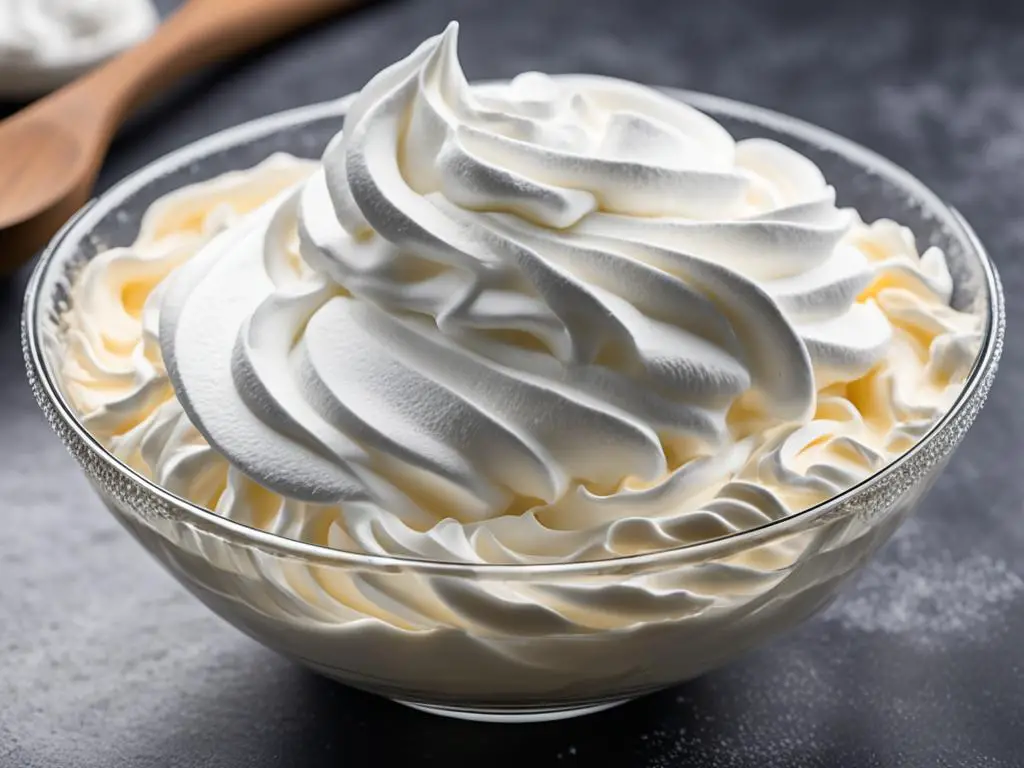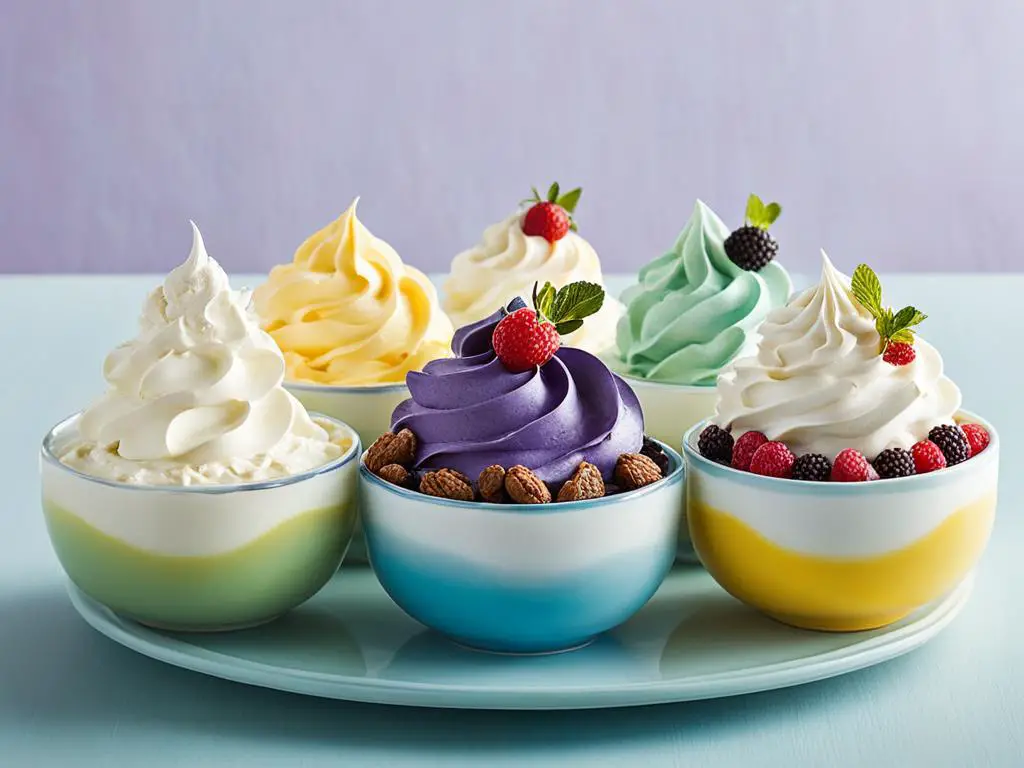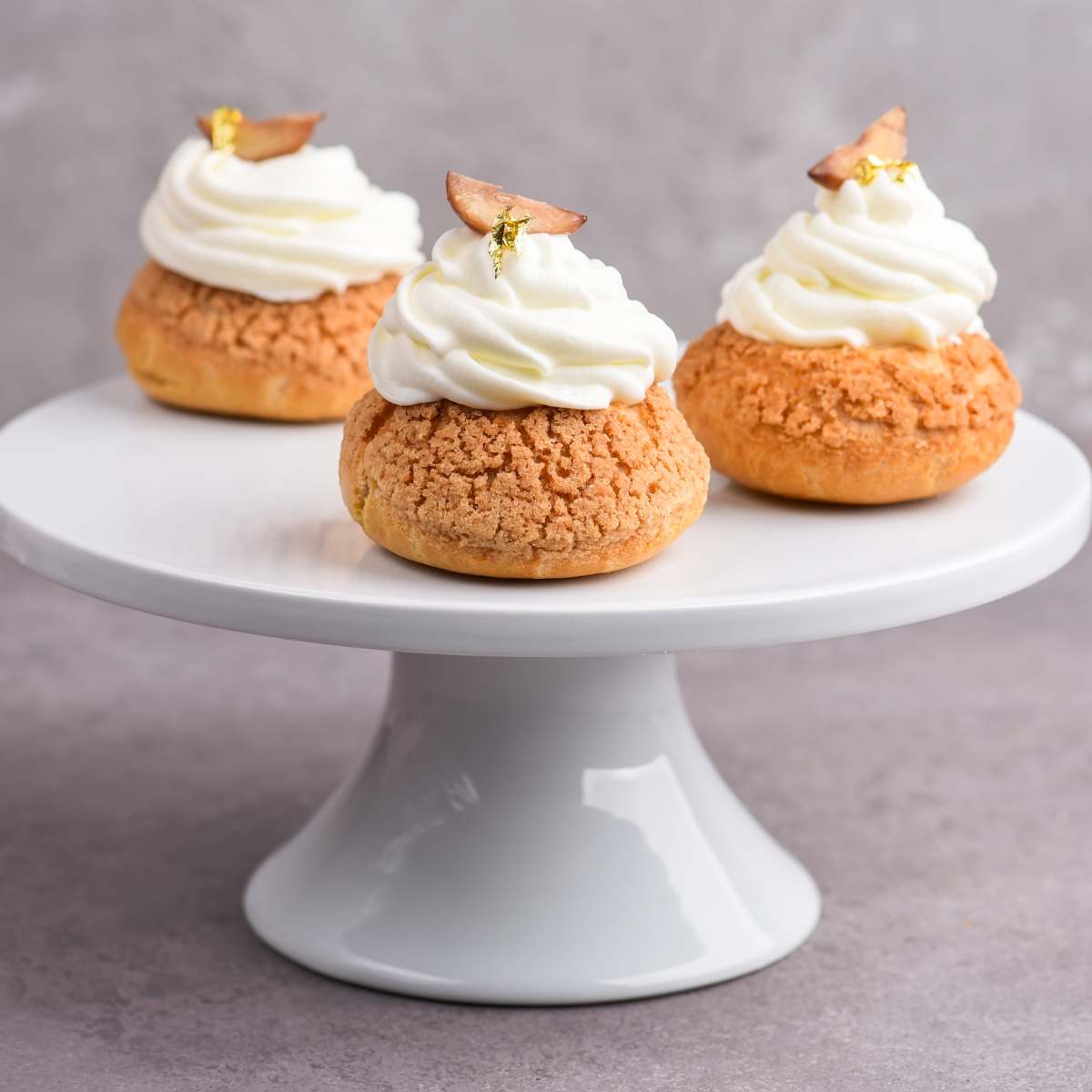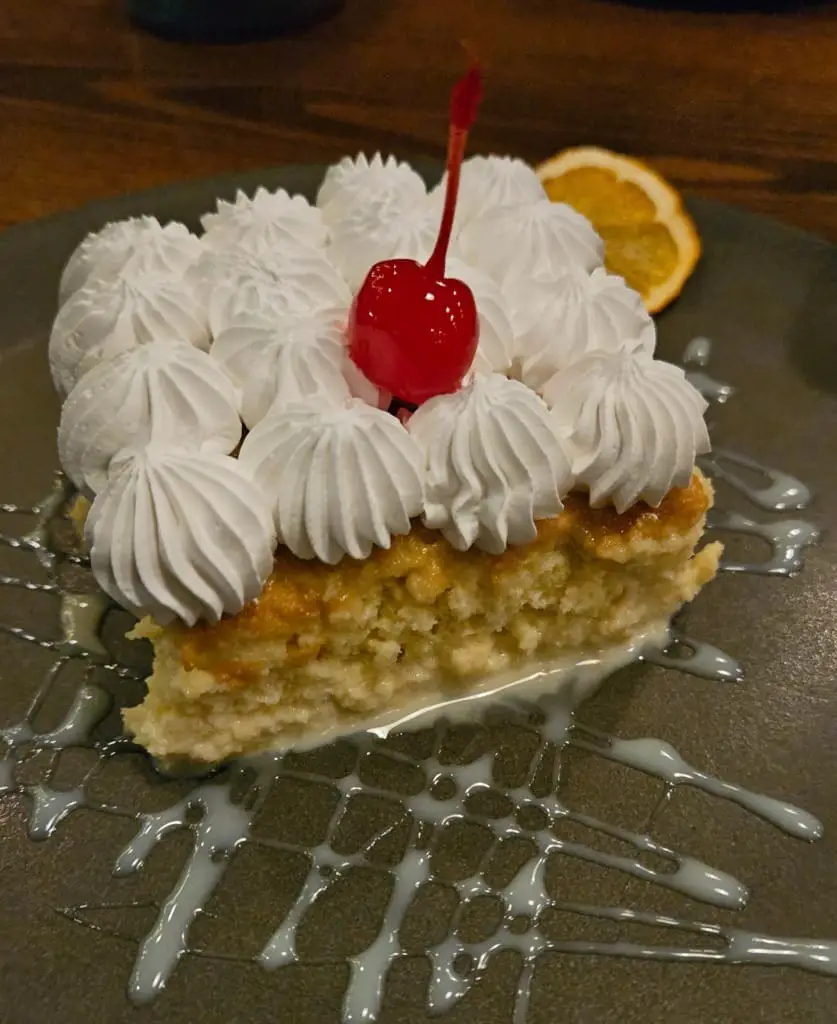While indulging in your favorite dessert in an upscale French restaurant, have you ever wondered about that light, airy, and utterly delectable garnish accompanying your treat? That’s Chantilly cream, a posh name for the oh-so-familiar whipped cream.
So, what is chantilly cream exactly? This article delves into the nuances that make Chantilly cream a beloved addition to sweets worldwide. From its basic ingredients to tips for making your own, you’ll find everything you need to enhance your next dessert. Keep reading to unlock the secrets of crafting the perfect Chantilly cream.
The Elegant History of Chantilly Cream
Chantilly cream’s remarkable past not only tells a tale of tragedy and culinary innovation but also marks it as a gastronomic gem in the world of desserts.
The history of chantilly cream dates back to the 1670s, when François Vatel, a renowned chef, crafted this delectable delight for a grand banquet in honor of King Louis XIV. The feast, attended by over 2,000 guests at the Château de Chantilly, was a lavish affair with exquisite culinary creations designed to impress the king.
Vatel tragically met his end following the event, as the pressure of orchestrating such an opulent feast led to his untimely demise. Nevertheless, his light, vanilla-scented, and sweetened whipped cream invention continues to be a favorite in kitchens across the globe.
What Is Chantilly Cream?
Chantilly cream is a light and airy dessert topping made by sweetening heavy cream with sugar—preferably powdered for a smooth texture—and flavoring it with vanilla or other extracts. This delicately whipped cream is synonymous with the whipped cream familiar to many Americans, albeit with an elegant French flair.
As a highly versatile dessert topping, Chantilly cream is perfect for accenting a myriad of treats, from fruit tarts, pies, and chocolate mousses to enhancing the simplest of scoops of ice cream. Its sweetened, airy nature complements a wide array of desserts, making it a timeless addition to every pastry chef’s repertoire.

Chantilly vs. Whipped Cream: Understanding the Differences
Understanding the Chantilly cream definition starts with recognizing its distinction from ordinary whipped cream. Chantilly cream and whipped cream may seem similar at first glance, both airy and light, yet they differ subtly in ingredients and flavor. Standard whipped cream typically consists of just cream and sugar, whipped until fluffy.
Chantilly cream, on the other hand, is enhanced with vanilla extract and sometimes additional flavorings or sweeteners, lending it a more luxurious taste and aroma. This distinction sets Chantilly cream apart, making it a favorite for adding a touch of elegance to desserts.
Whipping Up the Perfect Chantilly Cream: A DIY Guide
Creating your homemade Chantilly cream is an achievable endeavor, even for the most amateur pastry chef. Here’s how to whip up this luxurious topping with just a few key steps:
- Chill Your Tools and Ingredients: Start with cold heavy cream and ensure that your mixing bowl and beaters are chilled. This helps achieve the light, airy texture that Chantilly cream is known for. You might want to place your tools in the freezer for a few minutes before you begin.
- Mix the Ingredients: In your chilled bowl, combine the heavy cream with sifted powdered sugar, also known as confectioners’ sugar and a splash of vanilla extract for that classic Chantilly flavor. Use a narrow, deep bowl to help maintain the cold temperature.
- Whip to Soft Peaks: Whip the mixture until it forms soft peaks. This is the perfect stage for Chantilly cream, where it’s still soft and billowy. Be careful not to over-whip, as it can quickly turn into butter.
- Adjust as Necessary: If you find the mixture is too thick, you can lighten it by gently folding in a little more cream until you reach the desired consistency.
- Watch Carefully: Overwhipping is one of the most common issues when creating Chantilly cream. If the cream is whipped for too long, it starts to lose its smooth texture and become grainy, eventually turning into butter if not corrected. To avoid this, keep a close eye on the cream and stop whipping as soon as it reaches the soft peaks stage.

With a little practice and attention to detail, you’ll soon master the art of making Chantilly cream. Equip yourself with this skill, and you’ll be ready to impress your guests or simply treat yourself and your family to the joys of this delightful, multi-purpose dessert topping.
Customizing Chantilly: Flavor Variations to Try
Transform your Chantilly cream experience by experimenting with a range of flavorings. While vanilla chantilly remains a classic choice, incorporating other extracts or even alcohol can bring exciting taste profiles to your delightful dessert topping.
Infusing Elegance: Vanilla and Beyond
Beyond the traditional vanilla flavor, other extracts like almond, mint, or even lavender can add an interesting twist to your Chantilly cream. Don’t be afraid to mix and match flavors, embracing both sweet and savory options for a unique and flavorful experience.

Alcohol-Infused Whipped Creams
Looking for an adventurous and sophisticated enhancement to your whipped cream? Try alcohol-infused whipped cream for a touch of extravagance at your next dinner party. Spirits like rum, bourbon, or amaretto can give your Chantilly cream a more complex and tantalizing flavor.
For those seeking an unconventional touch, substituting in sour cream or cream cheese offers a tangy depth and a rich, complex alternative to the traditional Chantilly concoction.
By exploring a variety of flavor options, you’ll be able to customize your Chantilly cream to fit any mood, dessert, or occasion. Whether garnishing something classic like a chocolate cake or experimenting with a trendy avocado brownie, your flavored Chantilly cream will add a memorable touch to any dessert.
American Delight: Chantilly Cream Stateside
Graceful, light, and irresistibly fluffy, Chantilly cream has captivated American taste buds, seamlessly integrating into the nation’s diverse culinary scene and dessert recipes. Its omnipresence in numerous dessert creations showcases its versatility and ability to elevate even the simplest of pastries.
Sweet Staples: American Pastries and Chantilly Cream
From Fruit Basket cakes to traditional sundaes, Chantilly cream has proven to be a go-to choice for sweetening a variety of American pastries.
Its airy texture complements dense cakes like the ever-popular chocolate ganache while offering a lavish touch to lighter fare, such as angel food cake. This patisserie staple has made itself at home in the United States, enhancing both classic and modern dessert creations alike.
Chantilly Cream as a Versatile Dessert Companion
Chantilly cream’s ability to harmonize with a diverse selection of desserts makes it an invaluable asset for bakers and pastry enthusiasts. Its presence as a topping turns ordinary pastries into memorable, delightful treats.
Experiment with a variety of Chantilly cream uses in your dessert endeavors, such as:
- Layering it atop a stack of fluffy pancakes
- Using it as a filling between cake layers
- Enhancing the flavor of cookies and bars
- Serving as an accompaniment to a fruit platter
- Blending it with other sweet toppings like caramel drizzle and chocolate sauce
Whether used sparingly or in heaping spoonfuls, Chantilly cream enriches classic American pastries and inventive dessert concoctions alike, proving that sometimes, the secret to an unforgettable treat is in the finishing touch.
Chantilly Cream in Popular Desserts: A Joyful Pairing
Chantilly cream’s delightful versatility allows it to enhance an array of classic desserts, taking your sweet treats to the next level. From airy cakes and buttery pies to fruit-rich creations, Chantilly cream finds its rightful place in a variety of beloved confections.
Elevating Classics: Cakes and Pies Enhanced
Chantilly cream adds an elegant touch to both simple and complex cake recipes, such as layered sponge cakes and decadent Black Forest cakes. Its light texture contrasts well with heavier confections like caramel tarts or chocolate ganache-covered desserts.
Many American pies, including Pumpkin, Pecan pie, and Apple pie benefit from a generous dollop of silky Chantilly cream, complementing their rich flavors and buttery crusts.
Fresh Fruits and the Lightness of Chantilly
Fresh fruit becomes even more irresistible when paired with the airy delight of Chantilly cream. A spoonful atop a colorful fruit salad or a baked cherry tart can make all the difference, turning it into a true indulgence. Moreover, Chantilly cream’s subtle sweetness enhances the natural flavors of fruit without overpowering them.
Preserving Chantilly Cream: Tips for Longer Usage
While Chantilly cream is best consumed immediately after preparation, various methods can extend its life, allowing you to savor its exquisite taste for longer periods. Here are a few key strategies you can employ:
- Use Stabilizers: Adding stabilizers like crème fraîche or sour cream can help maintain the texture and stability of Chantilly cream. These ingredients make the cream more robust and ideal for longer storage.
- Fixing Over-whipped Cream: If you accidentally over-whip the cream, you can rescue it by adding a little more cream and gently folding it in. This helps bring it back to the right consistency without starting over.
- Refrigeration: Always store Chantilly cream in the refrigerator in an airtight container to keep it fresh. Place it away from strong odors to prevent flavor contamination.
- Freezing for Future Use: For long-term storage, freeze Chantilly cream in dollops on a baking sheet, then transfer to a freezer-safe container. These can be used later as a luxurious topping for hot drinks or desserts, providing a taste of indulgence anytime.
Conclusion
Chantilly cream is more than just whipped cream; it’s a versatile and luxurious treat that elevates any dessert. This cream’s silky texture and subtle vanilla flavor make it a staple in both home kitchens and professional bakeries. As you explore the recipes and tips shared in this article, you’ll gain the confidence to incorporate Chantilly cream into your culinary creations.
Whether you’re dressing up a simple piece of cake or adding a touch of elegance to a fruit bowl, Chantilly cream is sure to impress. Embrace the simplicity of this delightful cream and let it inspire your dessert menu.
FAQ
Can I make Chantilly cream without vanilla?
Yes, you can make Chantilly cream without vanilla; however, vanilla adds a distinct flavor that characterizes traditional Chantilly cream.
Is Chantilly cream suitable for lactose-intolerant individuals?
Chantilly cream is made from dairy, so it is not suitable for those who are lactose intolerant unless you use lactose-free heavy cream.
Can you flavor Chantilly cream differently?
Yes, while the vanilla extract is a classic choice, you can customize Chantilly cream with other flavorings such as almond extract, rum, or even sour cream or cream cheese for a tangy twist.
What’s the difference between fresh Chantilly cream and store-bought canned whipped cream?
Fresh Chantilly cream has a richer flavor and lighter texture compared to store-bought canned whipped cream, which often lacks the subtle vanilla scent and airy quality of homemade Chantilly. Canned whipped cream offers convenience but sacrifices some of the culinary quality of freshly made Chantilly cream.



